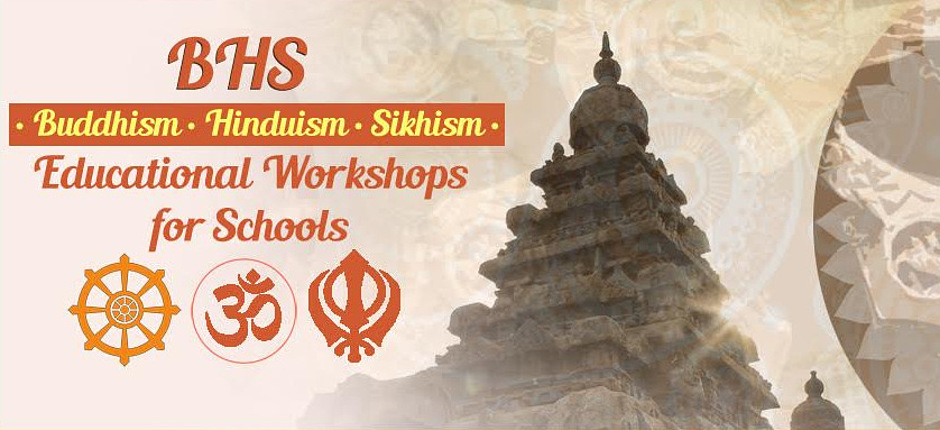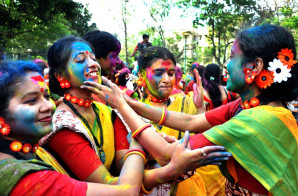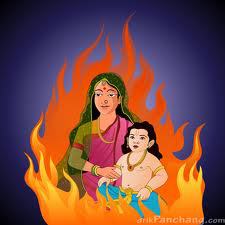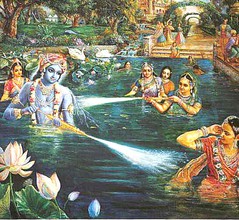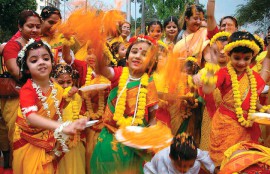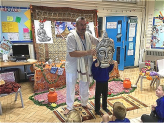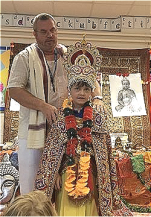Festival of Holika (Holi)
Celebrated in March, we bring this festival to life in your school by dressing students as the king Hiranyakashipu, his sister Holika and his saintly son called Prahalad. The colours are celebrated by Hindus (and non Hindus) all over the world by smearing powdered colour on each others faces. However, we only bring the powder as an artifact to be looked at and don't allow the students to throw it aroung and make a mess of the hall or classroom.
Holi (English pronunciation:ˈhoʊli') (Sanskrit: होली) is a Spring festival also known as the festival of colours or the festival of love. It is an ancient Hindu religious festival which has become popular with non-Hindus in many parts of South Asia, as well as people of other communities outside Asia.
It is primarily observed in India, Nepal, and other regions of the world with significant populations of Hindus or people of Indian origin. The festival has, in recent times, spread to parts of Europe and North America as a spring celebration of love, frolic, and colours.
Holi celebrations start with a Holika bonfire on the night before Holi where people gather, sing and dance in celebrations of good over evil. Holika - a character from the ancient Purana literatures was the paternal aunt of Prahalad, a devotee servant of Lord Vishnu. The word "Holi" originates from "Holika", the evil sister of demon king Hiranyakashipu.
King Hiranyakashipu had earned a boon that made him virtually indestructible. The special powers blinded him, he grew arrogant, considered himself to be God, and demanded that everyone worshiped only him. Hiranyakashipu's own son, Prahlada, however, disagreed. He was and remained devoted to Vishnu. This infuriated Hiranyakashipu. He subjected Prahlada to cruel punishments, none of which affected the boy or his resolve to do what he thought was right. Finally, Holika - Prahlada's evil aunt - tricked him into sitting on a pyre with her. Holika was wearing a cloak (shawl) that made her immune to injury from fire, while Prahlada was not. As the fire roared, the cloak flew from Holika and encased Prahlada. Holika burned, Prahlada survived. Vishnu appeared and killed Hiranyakashipu. The bonfire is a reminder of the symbolic victory of good over evil, of Prahlada over Hiranyakashipu, of fire that burned Holika.
(also called Holaka or Phagwa) is an annual festival celebrated on the day after the full moon in the Hindu month of Phalguna (early March). It celebrates spring, commemorates various events in Hindu mythology and is time of disregarding social norms and indulging in general merrymaking. Holi is probably the least religious of Hindu holidays. During Holi, Hindus attend a public bonfire, spray friends and family with colored powders and water, and generally go a bit wild in the streets. - See more at: http://www.religionfacts.com/hinduism/holidays/holi.htm#sthash.0gl6THb1.dpuf
Holi (also called Holaka or Phagwa) is an annual festival celebrated on the day after the full moon in the Hindu month of Phalguna (early March). It celebrates spring, commemorates various events in Hindu mythology and is time of disregarding social norms and indulging in general merrymaking. Holi is probably the least religious of Hindu holidays. During Holi, Hindus attend a public bonfire, spray friends and family with colored powders and water, and generally go a bit wild in the streets.
- Also see: Diwali in Hinduism and Symbols of Hinduism
The central ritual of Holi is the throwing and applying of colored water and powders on friends and family, which gives the holiday its common name "Festival of Colors." This ritual is said to be based on the above story of Krishna and Radha as well as on Krishna's playful splashing of the maids with water, but most of all it celebrates the coming of spring with all its beautiful colors and vibrant life.
- See more at: http://www.religionfacts.com/hinduism/holidays/holi.htm#sthash.0gl6THb1.dpufFestival of Colours
The next morning is a free-for-all carnival of colours, where participants play chase and colour each other with dry powder and coloured water. They sometimes use water guns filled with coloured water-filled balloons for their water fight. Pn this day anyone and everyone is fair game, friend or stranger, rich or poor, man or woman, children and elders. There is a symbolic legend to explain why holi is well celebrated as a colour fest.
This water play was said to be performed over 5000 years ago by Lord Krishna and his queens in the ancient city of Dwarka, which was situated off the coast of Gujarat in Western India. Water guns were used in those days, spraying coloured water upon each other in a loving exchange of fun and frolic.
The fight with colours occurs in the open streets, open parks, outside temples and buildings. Groups carry drums and musical instruments, go from place to place, sing and dance. People move and visit family, friends and foes, first play with colours on each other, laugh and chit-chat, then share Holi delicacies, food and drinks.
Holi is celebrated at the approach of vernal equinox,on the Phalguna Purnima (Full Moon). The festival date varies every year, per the Hindu calendar, and typically comes in March, sometimes February in the Gregorian Calendar. The festival signifies the victory of good over evil, the arrival of spring, end of winter, and for many a festive day to meet others, play and laugh, forget and forgive, and repair ruptured relationships.
Festival of Colours in India Today
Holi is a very important festival to Hindus. It is celebrated at the end of the winter season on the last full moon day of the lunar month Phalgun (February/March), (Phalgun Purnima), which usually falls in March, sometimes in late February. The festival has many purposes; most prominently, it celebrates the beginning of Spring. In 17th century literature, it was identified as a festival that celebrated agriculture, commemorated good spring harvests and the fertile land.
Hindus believe it is a time of enjoying spring's abundant colours and saying farewell to winter. Holi festivities mark the beginning of new year to many Hindus, as well as a justification to reset and renew ruptured relationships, end conflicts and accumulated emotional impurities from past. Holi, also known as Dhuli in Sanskrit, or Dhulheti, Dhulandi or Dhulendi, is celebrated. Children and youth spray coloured powder solutions (Gulal) at each other, laugh and celebrate, while elders tend to smear dry coloured powder (Abir) on each other's face. Visitors to homes are first teased with colours, then served with Holi delicacies, desserts and drinks.
After playing with colours, and cleaning up, people bathe, put on clean clothes, visit friends and family. Like Holika Dahan, Kama Dahanam is celebrated in some parts of India. The festival of colours in these parts is called Rangapanchami, and occurs on fifth day after Poornima (full moon)
